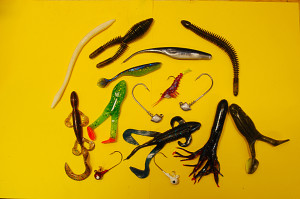By Chris Erwin
Note: this is the fifth in a five-part series on “Learn the four Bait Categories” It is our hope that anyone trying to learn more about bass fishing will gain some basic information and know how to improve your skills. If you have questions, you are welcome to send them to me. My email will be at the end of this article.

There was a time when anyone talking about soft plastics, the discussion was going to be about bottom dragging baits. That’s far from true today, with the innovation of many fishermen and lure manufactures soft plastics span the water table much the same as spinnerbaits or crankbaits.
From Topwater to mud-dragging bottom dwellers, soft plastics have become as versatile as any bait category we have covered.
One of the baits that have become very popular is the swim bait. They are more heads and ways to rig this bait than they are red heads in Ireland, and most of them catch fish. I will show you a few and some of the new rigs; however, before I get ahead of myself, I want to cover some of the basic of worm fishing.
If you want to be effective, even when no one is catching much, you need to learn the basic technics of working a worm. Before I get started just let me say nothing is cast in stone when it comes to fishing, and at times you can catch a fish on a dirty bologna skin but most of the time, the people that do the best learn how to fish plastic worms in a way that produces even in tough times.
The number-one rule for me is always to move the worm with the rod not the reel. Be a line watcher, many worm strikes move the bait to the side rather than just away from you and at times. The fish will bring the bait towards you.
When I was learning worm fishing, Bill Dance once told me in a seminar at Marshell College, and by the way, he wrote one of the first books on the subject “The Art of Worm Fishing” “not to get into a feeling contest with the fish. However, you must stay in contact with the bottom after some time you learn the difference between grass, rocks, trees and brush piles.” You do this by feeling the bait move as you lift and move the bait with the rod not the reel. Once you lift the rod and move the bait, you just take up the slack with the reel. It doesn’t take long to know when something hits you that’s not part of the structures you are moving your bait though.
When you take on this learning cure for soft plastics, you want to learn, the Alabama rig, the Texas rig, The Carolina rig, the Drop-Shot rig, the Whacky rig, and dead sticking. That still doesn’t cover single rigged swim-baits, Seiko soft plastics, tubes, and topwater weightless jerk plastics.
As time goes on we plan to make some how-to videos on all these different kinds of rigging and presentations. We will be posting them in the magazine. Our first one has already been filmed, and we hope to get it up soon. In that video, John Sparr owner of Elite Pro Custom Baits will show you how to rig one of his new hollow-swim-baits. His jig heads are some of the best I’ve ever seen.
As we head into the late summer and early fall, I will try to cover more tips and how-to articles to help you get in the game using soft plastics. If you have questions send them to me, and I will do my best to answer your questions. Until next time keep your lines tight and take a kid fishing. . Chris Erwin is the founder and publisher of Kentucky Angling News an on-line magazine available at www.kentuckyangling.com/magazine Chris can be reached by email chris@ashlandbeacon.com


Be the first to comment